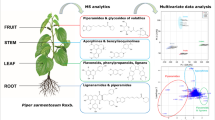Abstract
Sugar derivatives are critically important in nutritional, pharmaceutical, and some non-food industries. Amino sugars are more important as essential components of many drugs, antibiotics, and biopolymers. Hence, a novel amino sugar compound is worthy of investigation for identification and production. A novel amino sugar compound was identified from crude extracts of Korean pine seed embryos. This new compound was isolated from extracts using traditional purification steps. The pure compound was white in color with a melting point of 145°C. HPLC, TLC, FT-IR, and NMR analyses of the compound indicated a trisaccharide form of amino mannose that was polymerized with β-(1→2) glycosidic bonding. Computer-aided NMR spectral analysis of the trisaccharide of 2-dehydro-2-mannosamine exhibited a 96% match with the 13C-NMR spectrum of the new compound.
Similar content being viewed by others
References
Marchal LM, Beeftink HH, Tramper J. Towards a rational design of commercial maltodextrins. Trends Food Sci. Tech. 10: 345–355 (1999)
Imeson A. Thickening and Gelling Agents for Food. 3rd ed. Blackie Academic and Professional, London, UK. pp. 15–17 (1996)
Sanford PA. A survey of possible new polysaccharides. pp. 251–262. In: Polysaccharides in Food. Blanshard JMV, Mitchell JR (eds). Butterworths, London, UK. (1979)
Edwards CA. The physiological effects of dietary fiber. pp. 58–71. In: Dietary Fiber in Health and Disease. Kritchevsky D, Bonfield C (eds). Eagan Press, St. Paul, MN, USA (1995)
Inngjerdingen KT, Debes SC, Inngjerdingen M, Hokputsa S, Harding SE, Rolstad B. Bioactive pectic polysaccharides from Glinus oppositifolius (L.) Aug. DC., a Malian medicinal plant, isolation and partial characterization. J. Ethnopharmacol. 101: 204–214 (2005)
Sun Y, Tang J, Gu X, Li D. Water soluble polysaccharides from Angelica sinensis (Oliv.) Diels: Preparation, characterization and bioactivity. Int. J. Biol. Macromol. 36: 283–289 (2005)
Park JK, Khan T, Jung JY. Structural studies of the glucoronic acid oligomers produced by Gluconacetobacter hansenii strain. Carbohyd. Polym. 63: 482–486 (2006)
Saenz C, Sepulveda E, Matsuhiro B. Opuntia spp. Mucilage’s: A functional component with industrial perspectives. J. Arid Environ. 57: 275–290 (2004)
Ji XM. Mo J, Liu HM, Sun HP. Synthesis of new amino sugar derivatives from keto-sugars of D-xylose. Carbohyd. Res. 341: 2312–2320 (2006)
Soro P, Rassu G, Spanu P, Pianna L, Zanardi F, Casiraghi G. Total syntheses of 2,4-diamino-2-4-dideoxy-L-arabinose and 2,4-diamino-2,4-dideoxy-L-ribose. J. Org. Chem. 61: 5172–5174 (1996)
Voss AA, Diez-Sampedro A, Hirayama BA, Donald Loo DDF, Wright EM. Imino sugars are potent agonists of the human glucose sensor SGLT3. Mol. Pharmacol. 71: 628–634 (2007)
Butters TD, Dwek RA, Platt FM. Imino sugars inhibitors for treating the lysosomal glycosphingolipidoses. Glycobiology 10: 622–627 (2005)
Angelino NJ, Bernacki RJ, Sharma M, Dodson-Simmons O, Korytnyk W. Versatile intermediates in the selective modification of the aminofunction of 2-amino-2-deoxy-D-mannopyranose and the 3-postion of 2-acetamido-2-deoxy-D-mannose: potential membrane modifiers in neoplastic control. Carbohyd. Res. 276: 99–115 (1995)
Hitti M. Pine nut oil may cut appetite. Available from: http://www.medicinenet. com/script/main/art.asp?articlekey=60784. Accessed Oct. 15, 2006.
Miller GN. Use of dinitrosalicylic acid reagent for the determination of reducing sugar. Anal. Chem. 81: 426–428 (1959)
University of Calgary. Organic Laboratory Techniques 4. Available from: http://www.chem.ucalgary.ca/courses/351/laboratory/meltingpoint.pdf. Accessed Jul. 13, 2015.
Coimbra MA, Barros A, Barros M, Rutledge DN, Delgadillo I. Multivariate analysis of uronic acid and neutral sugars in whole pectic samples by FT-IR spectroscopy. Carbohyd. Polym. 37: 241–248 (1998)
Santhiya D, Subramanian S, Natarajan KA. Surface chemical studies on sphalerite and galena using extracellular polysaccharide isolated from Bacillus polymyxa. J. Colloid. Interf. Sci. 256: 237–248 (2002)
Shi Y, Sheng J, Yang F, Hu Q. Purification and identification of polysaccharide derived from Chlorella pyrenoidosa. Food Chem. 103: 101–105 (2007)
Gi YK, Hyung SP, Byong HN, Sang JL, Jae DL. Purification and characterization of acidic proteo-heteroglycan from the fruiting body of Phellinus linteus. Bioresour. Technol. 89: 81–87 (2003)
Wang L, Zhang H, Zhang X, Chen Z. Purification and identification of a novel heteropolysaccharide RBPS2a with anti-complementary activity from defatted rice bran. Food Chem. 110: 150–155 (2008)
Xu F, Sun JX, Geng ZC, Liu CF, Ren JL, Sun RC, Fowler P, Baird MS. Comparative study of water-soluble and alkali-soluble hemicllulose from perennial ryegrass leaves (Lolium peree). Carbohyd. Polym. 67: 56–65 (2007)
Zhao M, Yang N, Yang B, Jiang Y, Zhang G. Structural characterization of water-soluble polysaccharides from Opuntia monacantha cladodes in relation to their anti-glycated activities. Food Chem. 105: 1480–1486 (2007)
Chaikumpollert O, Methacanon P, Suchiva K. Structural elucidation of hemicelluloses from vetiver grass. Carbohyd. Polym. 57: 191–196 (2004)
Rao RSP, Muralikrishna G. Structural characteristics of water-soluble feruloyl arabinoxylans from rice (Oryza sativa) and ragi (finger millet, Eleusine coracana): Variations upon malting. Food Chem. 104: 1160–1170 (2007)
Nie S, Xie M, Fu Z, Wan Y, Yan A. Study on the purification and chemical compositions of tea glycoprotein. Carbohyd. Polym. 71: 626–633 (2008)
Gupta S, Madan RN, Bansal MC. Chemical composition of Pinus caribaea hemi-celluloses. Tappi J. 70: 113–114 (1987)
Chiovitti A, Bacic A, Craik DJ, Munro SLA, Kraft GT, Liao ML. Cell-wall polysaccharide from Australian red algae of the family Solieriaceae (Gigartinales, Rhodophyta): Novel, highly pyruvated carrageenans from the genus Callophycus. Carbohyd. Res. 299: 229–243 (1997)
Ajisaka K, Matsuo I, Isomura M, Fujimoto H, Shirakabe M, Okawa M. Enzymatic synthesis of mannobioses and mannotrioses by reverse hydrolysis using alpha-mannosidase from Aspergillus niger. Carbohyd. Res. 270: 123–130 (1995)
Vinogradov E, Li J, Sadovskaya I, Jabbouri S, Helander IM. The structure of the carbohydrate backbone of the lipopolysaccharide of Pectinatus frisingensis strain VTT E-79104. Carbohyd. Res. 339: 1637–1642 (2004)
Urai M, Anzai H, Ogihara J, Iwabuchi N, Harayama S, Sunairi M, Nakajima M. Structural analysis of an extracellular polysaccharide produced by Rhodococcus rhodochrous strain S-2. Carbohyd. Res. 341: 766–775 (2006)
Author information
Authors and Affiliations
Corresponding author
Rights and permissions
About this article
Cite this article
Kalam Azad, M.A., Wang, F. & Kim, HR. Identification of a novel sugar compound from Korean pine seeds. Food Sci Biotechnol 24, 2011–2015 (2015). https://doi.org/10.1007/s10068-015-0265-y
Received:
Revised:
Accepted:
Published:
Issue Date:
DOI: https://doi.org/10.1007/s10068-015-0265-y




